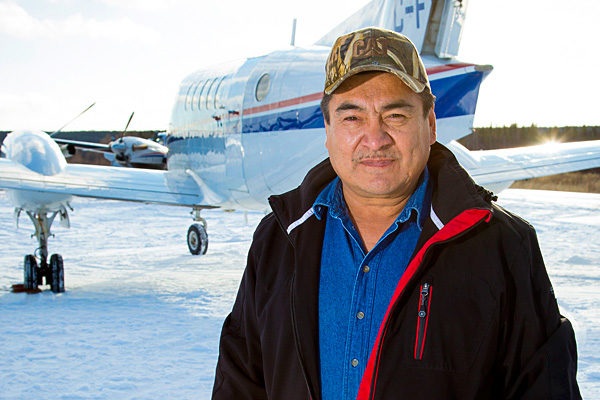Canada’s Best Diversity Employers 2015
March 31, 2015

Cameco’s Freddie Throassie at the Stony Rapids airport in northern Saskatchewan
Cameco has deep roots in Aboriginal communities
Freddie Throassie is getting used to travelling far from northern Saskatchewan and his First Nations roots from time to time. As a community liaison for Cameco, one of the world’s largest uranium producers, he found himself in the deep outback of Australia, meeting with people from the Aboriginal communities where Cameco was exploring.
At a gathering in the desert, Freddie was encouraged to deliver his presentation in his Dene language, with a translation afterward. “It was a very special experience,” he recalls. “All the elders got up off the sand to shake my hand. It meant a lot to me.”
Throassie, who has served as a chief of his own First Nation community in Black Lake, Sask., is an example of Cameco’s commitment to working with the Aboriginal communities located near its operations. Its four major sites are located in the Athabasca Basin in far northern Saskatchewan, where most of the 12,000 residents are Aboriginal people of Dene or Cree heritage. Cameco also has operations in Ontario, the U.S., Australia and Kazakhstan.
vice-president of human resources
Under an arrangement with the provincial government, Cameco has a long-term target of 67 per cent of the local workforce being residents of Saskatchewan’s north, or RSNs. The current tally has reached about 50 per cent of the 2,800 people working for Cameco and its contractors at the four sites, says Lynn McNally-Power, vice-president of human resources. “The numbers have grown substantially over our history.”
The company puts a lot of effort into spurring that growth. Throassie is one of five liaison officers who work for both Cameco and Areva Resources in northern Saskatchewan to do a wide range of support work with local communities, both to explain the ways of the uranium industry and to help people get involved in it. He goes into schools to advise on employment and encourage kids to study math and science, assists with applications and resumes, engages with elders and community groups and helps employees get services they need.
“We encourage the free flow of information between the company and the communities in the Athabasca Basin,” he says. At times he takes that expertise outside Saskatchewan, travelling for the company to communities in Nunavut, Quebec and his three-week stint in Australia.
Cameco also offers scholarships and summer employment to local students, as well as a career development program for northern employees. And it ensures that its contractors and suppliers have proper diversity and inclusion policies as well.
“Our approach recognizes the strong emphasis we put on local hiring and on supporting the communities in which we operate, in terms of employment, business opportunities and educational outreach,” says McNally-Power. For female employees, the company also supports involvement with the Women in Mining and Women in Nuclear industry groups.
Cameco’s seven-days-on, seven-days-off work schedule suits the traditional lifestyle some employees like to stay in touch with. Each week, planes fly the workers to and from about a dozen northern communities, as well as larger centres.
Throassie uses some of his free time to take at-risk youth on canoe trips to teach them about living off the land and about the heritage of their ancestors. “It gives me great pleasure to be that link,” he says. Several of the young people now work at Cameco. For work, he often takes managers and fellow employees into the wilderness as a team-building exercise. “I make them aware of our culture,” he says. Recently, he was even set to take the visiting president of the Kazakhstan operation out hunting.
But the company’s most distinctive nod to its Aboriginal workforce may be the three elders it employs part-time at the mine sites, available for any worker to consult about issues at work or at home. “The elders are recognized and respected in the Aboriginal community,” says Throassie. “They listen to the younger workers and counsel them, and they also take their concerns back to Human Resources. They are role models.”
Reproduced with permission from the Canada’s Best Diversity Employers (2015) announcement magazine. © 2015 Mediacorp Canada Inc., all rights reserved.
